| observatory sites |
|
There are no optical telescopes in the UK which can now be regarded as world class. Arguably, the same applies to the whole of continental Europe. The reason is simple: the world's largest telescopes now cost hundreds of millions of pounds to build, and hence it makes sense to site them in the best possible places for astronomical observing, none of which are located in Europe. The factors which dictate whether or not an astronomical site is a good one are discussed below.
latitude
The first decision to be made is whether to site a telescope in the northern or southern hemisphere. The southern sky is arguably the more interesting, as it contains both the galactic centre and the two nearest galaxies to our own - the Small and Large Magellanic Clouds. The northern sky has an historic advantage in that it is arguably the better studied sky, hence there tend to be more members of each class of astronomical object known in the north (although this situation is rapidly changing). Neither argument is overwhelming, however, and the fact is that telescopes are required in both hemispheres in order to access the entire sky. Telescopes sited close to the equator can access much of both hemispheres, of course, so this is often a good compromise. Siting telescopes closer to the poles has the disadvantage that the Sun never gets sufficiently below the horizon in the summer months for the sky to become truly dark, although the longer winter nights can be advantageous for certain astronomical projects, e.g. monitoring stellar variability.
cloud cover
Although radio telescopes can peer through cloud, optical telescopes cannot. Hence, finding a site with relatively little cloud cover means that a telescope can be used for a larger number of nights per year, maximising the investment made in the facility. This is one of the primary reasons there are no major research telescopes in the UK! Desert regions, including the Arctic, Antarctica, Australia, parts of Africa and the western coast of the Americas appear to provide some of the best cloud conditions in this respect, as shown in figure 46.
| figure 46: |
A map of the world's
percentage cloud cover, averaged over a 7-year period.
|
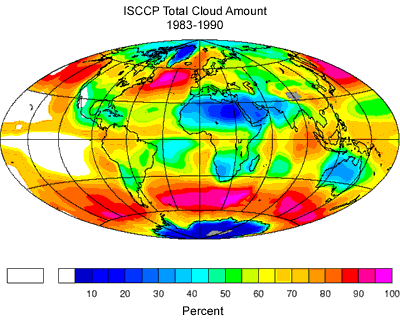
light pollution
| figure 47: |
A map of the artificial night sky brightness in the world.
|
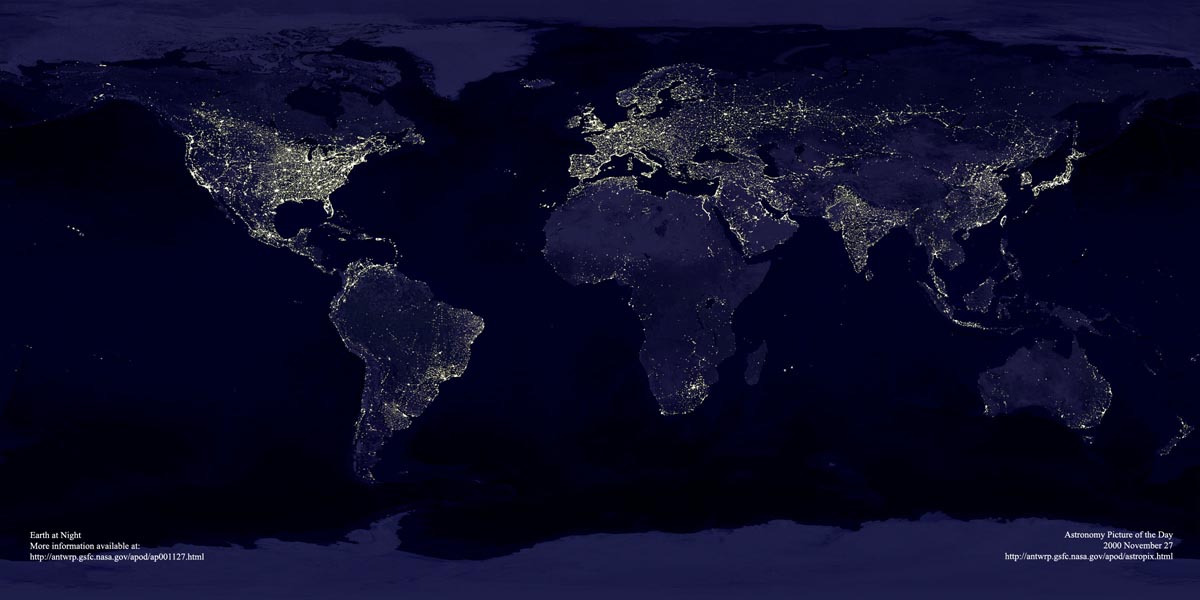
seeing
Selecting a site with good seeing is of prime importance, as lower seeing improves both the spatial resolution and the signal-to-noise ratio of astronomical images, thereby exploiting the apertures of the world's largest telescopes to their maximum. The atmosphere over the sea tends to be much less turbulent than the atmosphere over land, as the sea exhibits an essentially smooth, constant-temperature surface compared to the land. Some of the best astronomical sites are therefore located on small islands in the middle of oceans, such as Hawaii and the Canaries, as these small land masses cause little additional turbulence. For the same reason, coastal regions that receive winds predominantly from the direction of the ocean, such as the western coasts of the Americas and Africa, also exhibit excellent seeing.
The best seeing on Earth has recently been shown to exist in Antarctica. Atmospheric turbulence is caused by heat from the ground rising through the atmosphere, and wind stirring the atmosphere up. At mid-latitudes, there are numerous layers of strong winds (e.g. the jet stream) which cause lots of turbulence; above Dome C on the high plateau in central Antarctica, however, the ground is cold and winds are low throughout the atmosphere, leading to low turbulence and hence excellent seeing.
height above sea level
Siting telescopes at altitudes of approximately 2000 m above sea level provides a number of advantages for astronomical observations. It places the telescope above a significant fraction of the Earth's atmosphere, reducing the thickness of air that sources are observed through. This reduces the atmospheric extinction and can also reduce the seeing if some of the turbulent layers lie below the altitude of the telescope. High-altitude telescopes are also often above the local inversion layer in the atmosphere, meaning that local cloud formation occurs below the telescope, significantly increasing the number of usable nights at the observatory compared to a telescope sited below the inversion level.
Figure 48 shows that the mountainous western coasts of the Americas and Africa provide favourable altitudes to site astronomical telescopes, as do the volcanic island-chains such as Hawaii and the Canaries. The Antarctican plateau, and parts of the Arctic, are also at a high altitude.
| figure 48: |
A colour-coded map of
the world where areas in white, brown, yellow and green indicate
decreasing height above sea level.
|
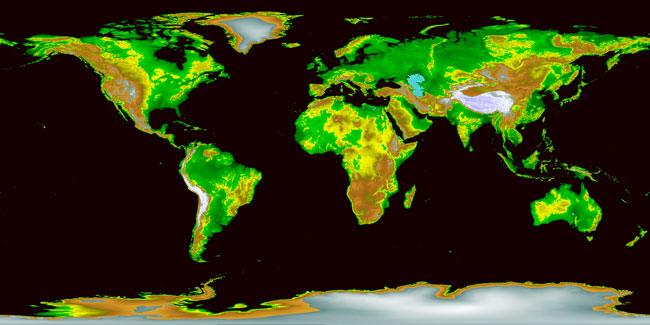
humidity
Water vapour in the Earth's atmosphere has only a marginal impact upon optical observations, but it is a very significant source of absorption of the infrared light from astronomical sources. Since most large optical telescopes built today have also been designed to operate in the near infrared, finding sites with low water-vapour content is of importance. Figure 49 shows that the western coastal regions of the Americas and Africa are extremely arid (in fact, the Atacama desert in Chile is the driest place on Earth). Counter-intuitively, although not apparent from figure 49, parts of the Antarctican plateau and the Arctic also exhibit very low humidity.
| figure 49: |
A map
showing how the average humidity varies with location in the world.
|
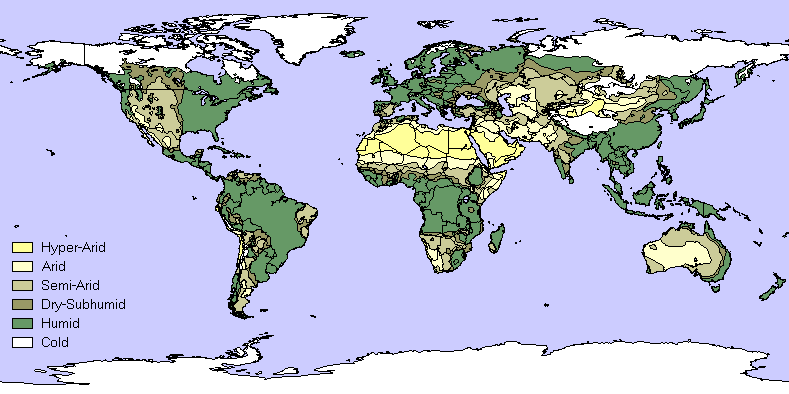
political stability
As well as geographic and atmospheric factors, political factors are also important when determining where to site a major telescope. For example, figure 50 shows the war zones in the world in 2002. Clearly, it would be extremely difficult to build and operate a telescope in a war zone. The same is true of any region in the world which is politically unstable - it is essential that the huge investment involved in building and operating a major telescope is not jeopardised by problems in recruiting staff, buying materials and services, accessing the site, etc.
| figure 50: |
A map
of the world in which territory size shows the proportion of deaths
worldwide in 2002 directly attributed to war or conflict that happened
there.
|
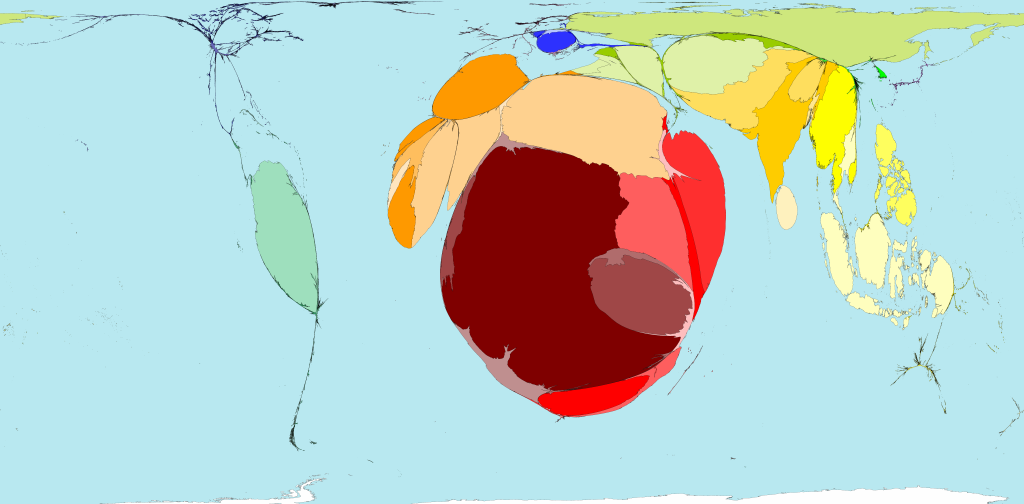
other factors
There are many other factors which come into play when selecting the optimum site for an observatory, some of which are related to those discussed above. These include:
sites of the world's largest telescopes
Figure 51 shows the sites of the world's largest telescopes. They are tightly clustered in only a few major sites, predominantly Chile, Hawaii and the Canary Islands. The reasons for this are clear from the preceding discussion: these sites have low cloud cover, low light pollution, good seeing and low humidity. They are all at high altitude and are politically stable.
| figure 51: |
A map showing the location of the world's 23 largest telescopes (with
apertures ranging from 4m to 10.4m), of which 9 are in Chile, 4 are
in Hawaii and 2 are in the Canary Islands. Below that are photographs of,
from top to bottom:
Paranal Observatory
in the Atacama Desert, Chile;
Roque de
los Muchachos Observatory on La Palma in the Canary Islands;
Mauna Kea
Observatory on Hawaii; Concordia Station at Dome C in
Antarctica.
|
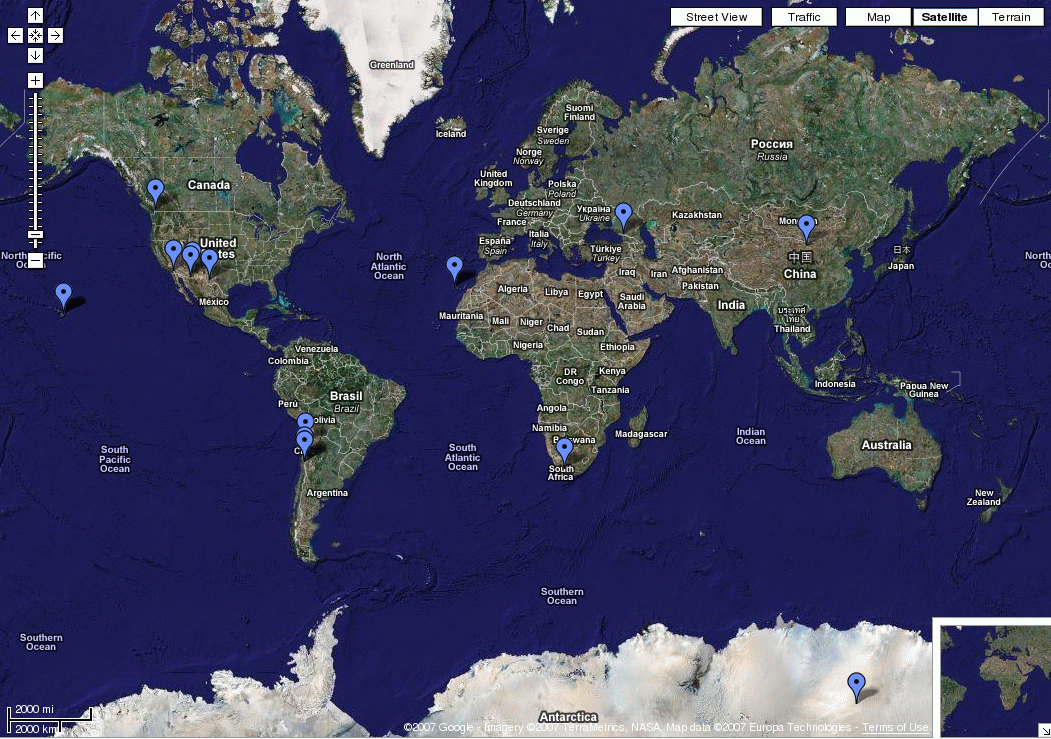
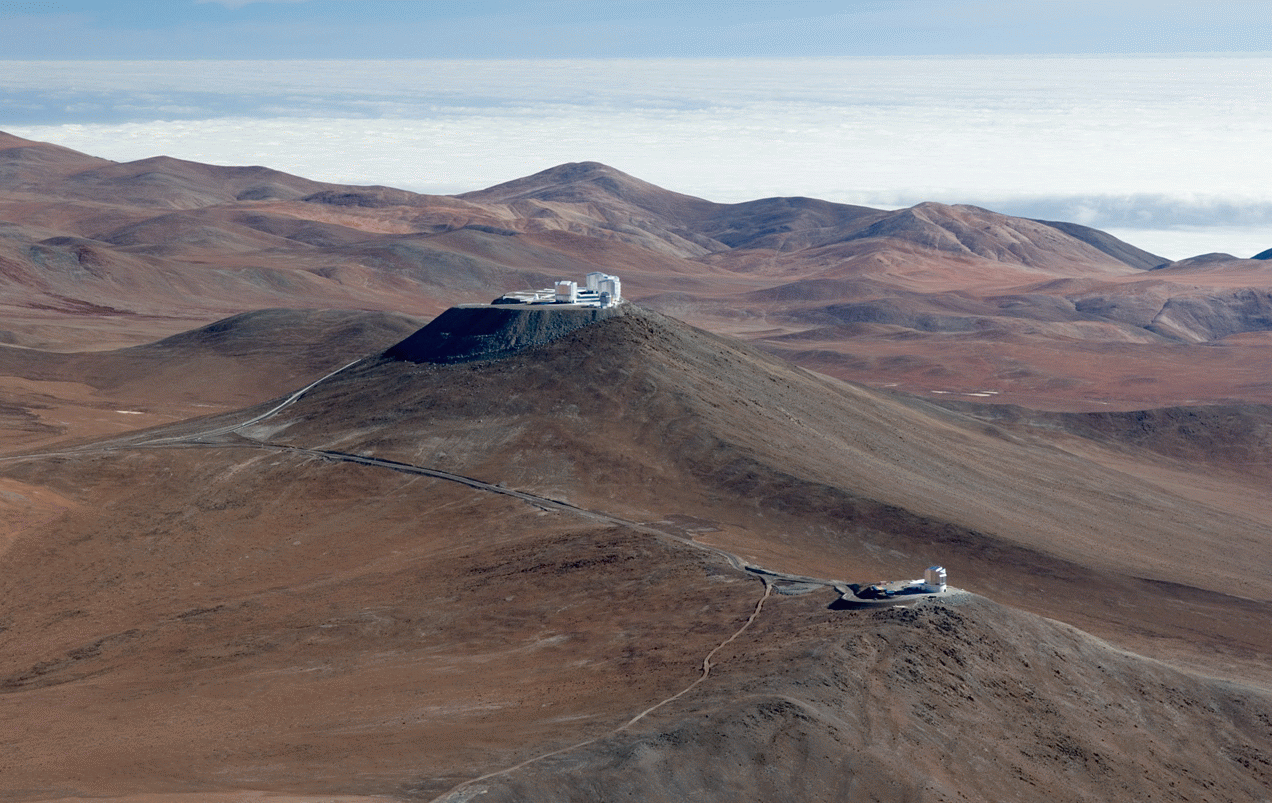
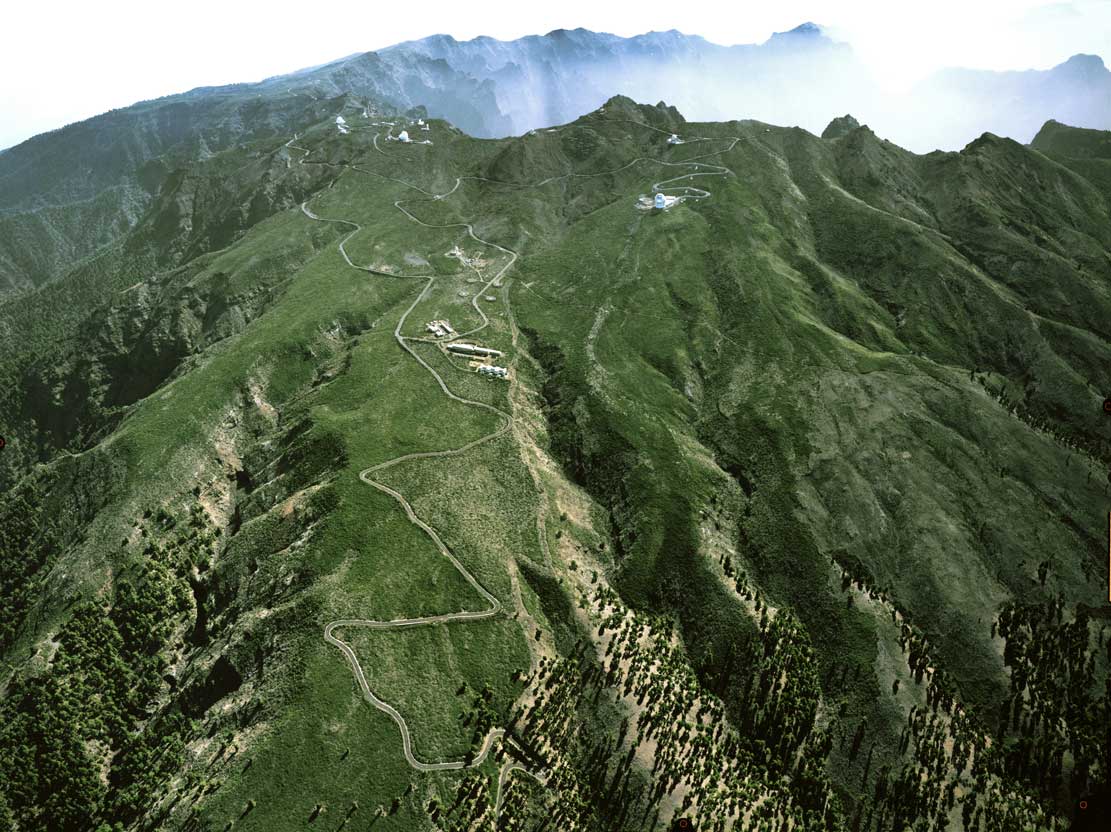
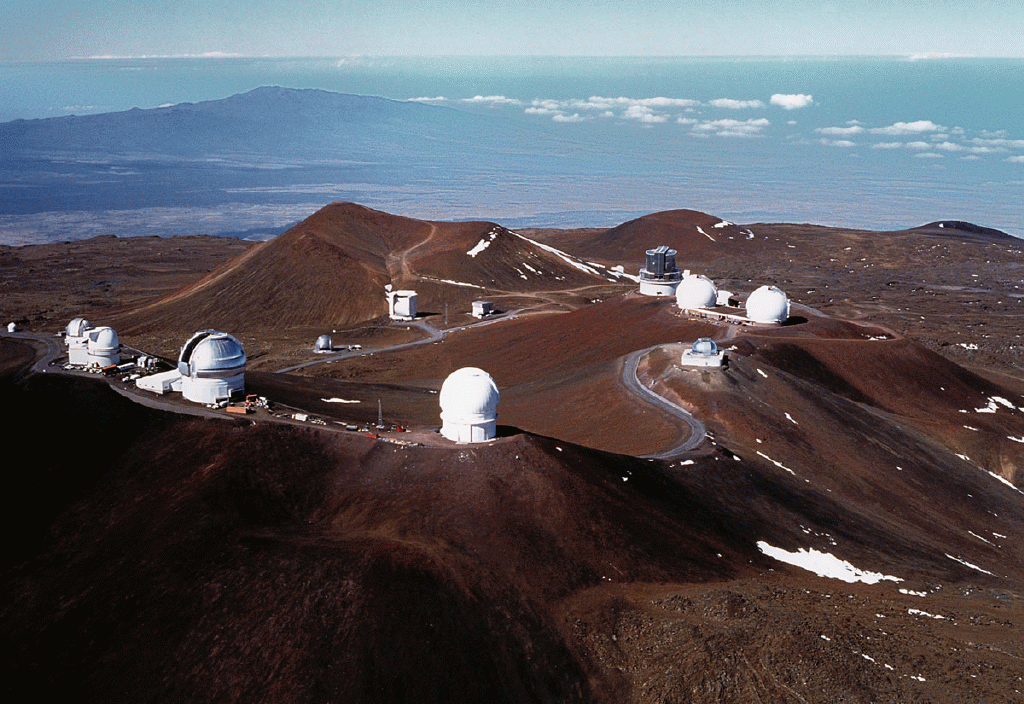
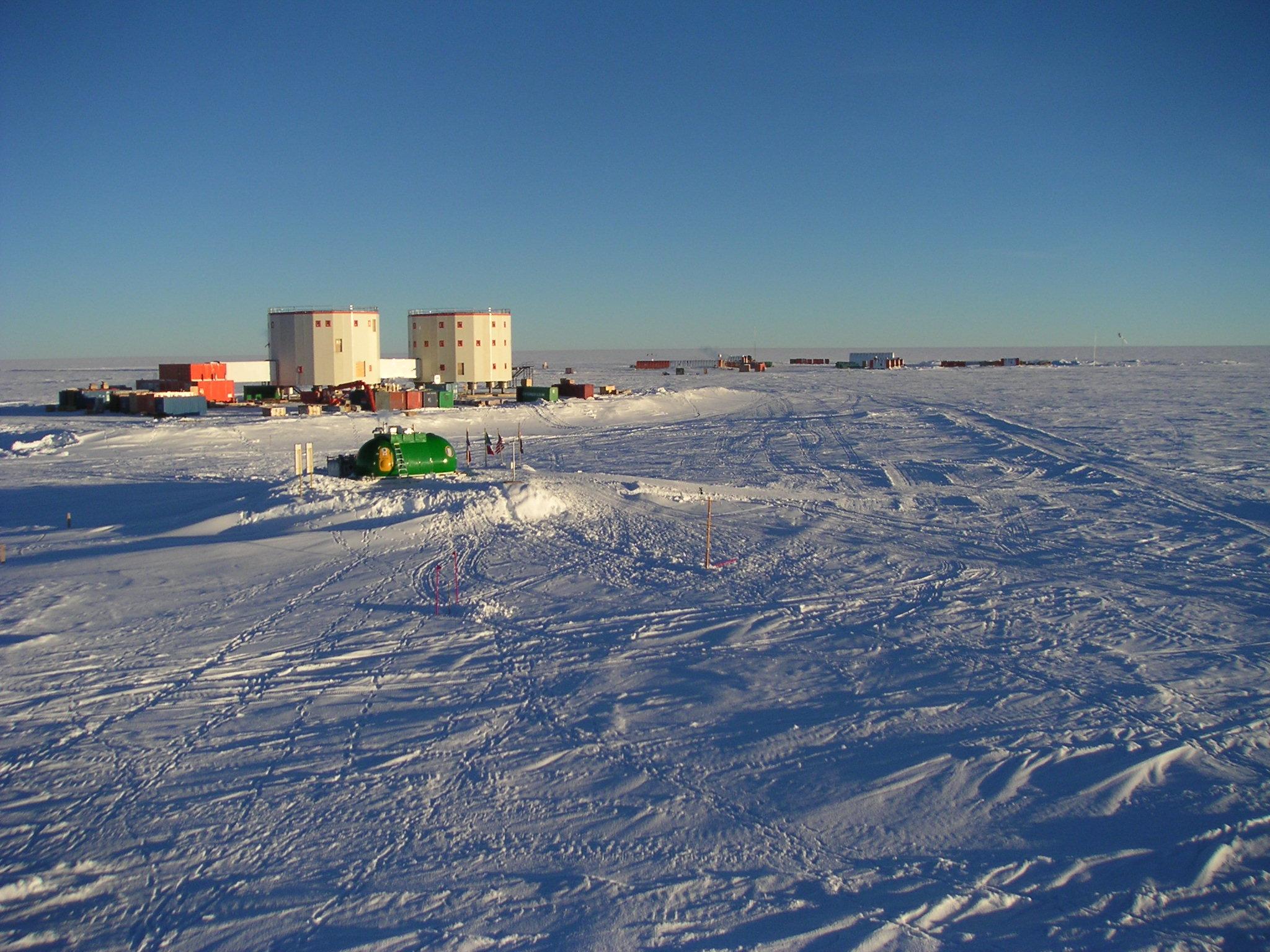
astronomy from space and antarctica
The factors which degrade astronomical images, such as seeing, sky background, transparency variations and extinction are all atmospheric-induced phenomena. These effects can all be removed at a stroke by siting optical telescopes in space. The best known example of this is the 2.4 m Hubble Space Telescope (HST, see figure 23), which has helped to revolutionise astronomy since 1990 with its diffraction-limited imaging capability. The main drawback with siting telescopes in space is the cost: the HST cost many billions of dollars to build and operate, approximately ten times the sum required for the largest ground-based telescopes. The primary reason for this cost difference is accessibility - rockets rather than lorries have to be used to transport the telescope to the site. Another drawback with space is the risk involved in the launch, and the great difficulty of fixing problems, servicing the telescope and upgrading the instrumentation once the telescope has been deployed. NASA solved this to some extent by ensuring the HST possesses extremely reliable/redundant systems and by using Space Shuttle servicing missions, but these were both costly solutions. Moreoever, the servicing missions, which cost nearly $1 billion each, were of limited number and were very risky for the astronauts involved.
Figure 51 also shows Dome C in Antarctica. Although not currently host to a major telescope, it is probably only a matter of time before the unique characteristics of this site are exploited. Antarctica offers imaging performance part way between that of the next best ground-based sites and space. Yet the difficulties of operating telescopes in Antarctican conditions, and of getting equipment and people there, means that the cost of building and operating a large telescope in Antarctica is also part way between that of a spaced-based mission and a ground-based telescope at a more temperate latitude. The same argument applies to the Arctic, which has large mountains bordering the Arctic Ocean that are very promising sites for telescopes.